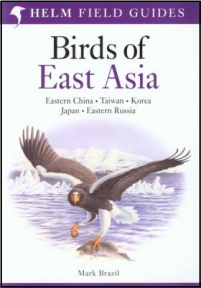Birds of East Asia by Mark Brazil

The meat of the book is the 472 pages devoted to the individual species, with text and distribution maps on one page and illustrations on the opposite page. The taxonomy and sequence are based on The Howard and Moore Complete Checklist of the Birds of the World (Dickinson 2003), which means Plate 1 is of Grouse. This makes it difficult to find families if, like me, you are unfamiliar with this arrangement. However, there is help in the earlier section, Key to Families, which lists all the families with plate numbers along with a general introduction to the family. The use of 16 pages for this may seem a little on the generous side. The species accounts include sections on status and distribution, habitat and habits, identification, colour of bare parts, and voice. Identification covers sex, age, time of year and, most importantly, subspecies. Field separation of subspecies in East Asia has not been attempted before in a book, and is probably in its infancy, but Mark has made a valiant attempt to give the latest view, within the constraints of available space. He states in the Introduction the laudable aim that he hopes this book will stimulate research into the identification, ecology, distribution, vocalizations and taxonomy of poorly known taxa such as the three "Great" Tits, whose split he has accepted: Parus major, minor and cinereus. The accounts certainly set a good starting point for this challenge to be taken up.
The amount of text is quite generous for a book of this size, helped by the small but clear print size and two-column layout. There are between three and six species per page, mostly four, with little wasted space. This compares very favourably with another good recent Helm Field Guide, Birds of Peru, of similar size, which has mostly six species per page and very little text on identification, subspecies or habits. The text seems to be accurate, although to say that Ijima's Warbler and Streaked Reed Warbler winter in the Philippines only is rather worrying as there is only one proven record for the former and the latter is very rarely seen; on the other hand Pied Harrier is a regular in winter in the Philippines, though not mentioned in the text. Song and calls have been transcribed for most species: very important, especially for passerines, although I can't really comment on accuracy.
The distribution maps are colour-coded to indicate summer, winter, resident, on migration and scarce. They are small but precise, and give a good indication of where the birds are likely to be found at the appropriate time of year. If your eyesight is declining, like mine, you may need a magnifying glass with you to examine them closely. Varying scales have been used so that the maps for species with small ranges are larger scale than for birds with wider distributions — this sounds confusing but works well in practice.
Taxonomy is always a contentious issue in field-guides — are the authors splitters or lumpers? Some can't resist the temptation to incorporate their favoured splits. Mark states that he has used Howard and Moore (Dickinson 2003) — less popular than the Clements list but more accurate for Asia — adding new species described in peer-reviewed journals, and has flagged potential splits by using distinct English names, e.g. Owston's Varied Tit. This is a good strategy in my view but it would have been helpful to quote the references for these additions somewhere, e.g. on the internet. I note that Taiwan has done particularly well with nine new splits (pigeon, barbet, shortwing and six babblers). A very useful table is included as an appendix, giving generalised status information for all the species for five geographic regions. It's a bit difficult to follow as it's all coded against species English name, but provides a potentially very useful data summary for trip planning, etc.
So, what of the illustrations? I think this is the finest collection of plates I have ever seen for Asian birds. For all species most of the main variations in plumage relating to gender, age and subspecies have been illustrated. Some species such as White Wagtail have as many as 10 forms in the plate. A few birds do look a bit odd, e.g. some of the eight Glaucous Gulls; some of the finches look rather dumpy but realistic in cold weather; the adult summer Red-faced Cormorant seems to have an orange, not red, face; but these are minor quibbles. All the plates are superb and I can't wait to return to eastern Asia to test them in the field. Even if you are not going there, this book could be very useful as it includes most British and European vagrants from the East and a huge selection of gulls, in nine plates. This book was a long time in preparation, the final cut-off being the end of 2006. It is a magnificent achievement, one that should stand the test of time, and well worth buying by every keen birder.
Softcover. 528 pp. 236 colour plates and species distribution maps.
RRP £29.99, ISBN-13: 0713670401 .


